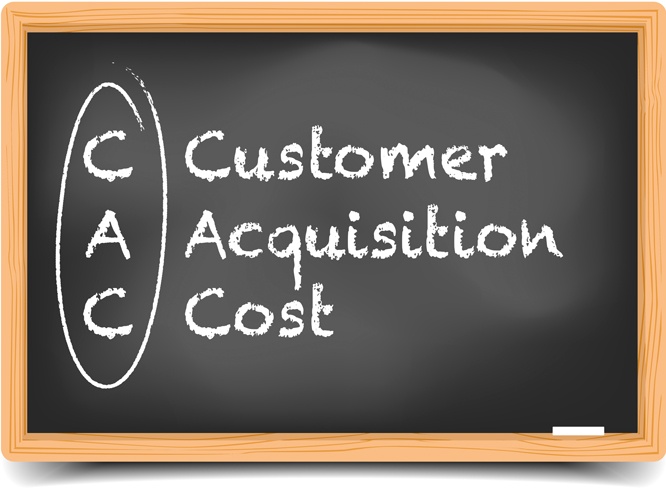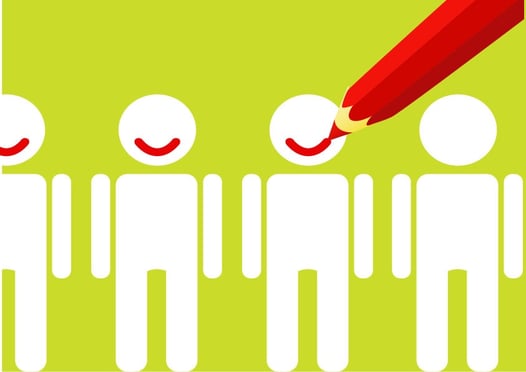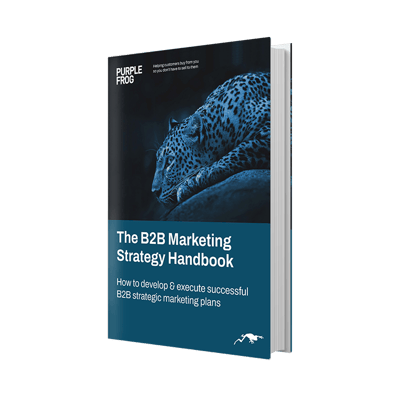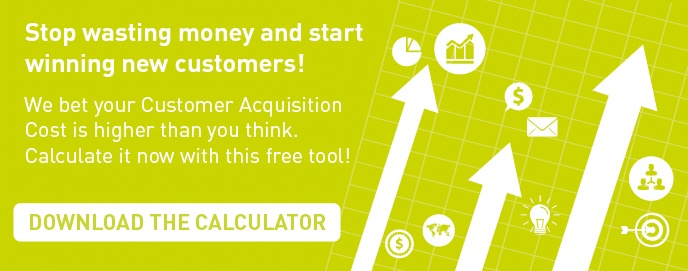Customer Acquisition Cost: The Secret To Your B2B Success


Stop spending, start investing. A new approach to customer acquisition that will show you how to grow your business by refocussing your investments and get double your money back.
The majority of businesses are overspending when it comes to acquiring new customers. The reason for this is that they don't actually know how much they should be investing or how, so they end up spending money in the wrong area and not see any return.
The crucial step for creating an effective customer acquisition strategy is to calculate how much money you should be investing on the various different marketing activities to acquire new customers, and have a granular approach for your budget allocation. This is what we call a customer acquisition cost, or CAC.
Calculating your CAC also helps you define specific goals for your company, by identifying how much business you should be winning to justify your spend. In fact, there is absolutely no value in spending money unless you can guarantee a return on it. You should be following a no wastage policy rather than just go for splashing your advertising left and right, hoping to pick up some business along the way.
Download the free customer acquisition cost calculator
In this article, we will explain the CAC metric in more detail, highlighting the common mistakes businesses make when it comes to calculating it, so that it can become an effective and useful tool for your customer acquisition strategy.
Why the Customer Acquisition Cost is Important to You
The CAC is very important both internally and externally to the company. Externally, it's a key metric that investors are going to be very interested in, especially at an early stage of a business or if there is a new product launch. It allows them to determine a company or new product's profitability by looking at the difference between how much money each customer will bring into the business and the costs of obtaining it.
If the cost of producing a product is the same or greater than its market price, your business will never be able to make a profit. Similarly, if the cost of acquiring a new customer is greater than the money that customer will ever bring into business over the years, then it probably means that your customer acquisition strategy is wrong, and investors won't invest in your idea. Simple logic.
Internally to your company, the CAC is an important metric for measuring the success of your marketing spend and for growing your company. If the cost of acquiring a new customer can be reduced, then it will consequently improve your margins and profit.
How to Get Your Customer Acquisition Strategy Right
1. Calculate Your Customer Acquisition Cost
Simply put, the CAC can be calculated by dividing all the costs spent on acquiring more customers by the number of customers acquired in the period the money was spent. So, for instance, if you have invested £100k last year in acquiring new customers, and you have acquired 10, then your CAC per customer is £10k
Now, some of you are probably thinking that you already know how to do that, so you can avoid reading the rest of this article, but what if we told you that the way you have done your calculations so far is wrong?
The majority of companies, when they are laying out a customer acquisition strategy, tend to just put in their marketing and advertising spend, forgetting all the additional costs that they should include in it.
For example, imagine that your manufacturing company is doing some exhibitions in order to attract new distribution partners. You shouldn't only include in your CAC the cost of the stand and of your marketing material, but also the wages of the marketing team that has done all the planning ahead of the exhibition, the cost of the transport to and from the location, the hotels, the food, the wages of the sales team who will then have to chase up the leads, etc. You will quickly notice that when you start factoring these things in, your cost per acquisition will increase in no time and your goals, budgets and overall strategy will change dramatically as a consequence of this.
The CAC should also be applied to existing clients. This may seem odd, as traditionally a customer acquisition strategy was only applied for attracting new prospects, but with the continuous diversification of the products that businesses offer and the speedy advancement of technology, this has changed.
Imagine you are a telecom company, traditionally specialised in selling pagers. We all know that pagers have been surpassed with new technologies, and for this reason you have developed a new two-way hands-free communication device that can be worn round the neck. You still want to continue offering your old pagers, as they are still used by a few hospitals you supply, but instead of spending your budget in retaining those customers, given that pagers are a dying market and these clients are ordering less and less every year, you should invest in moving those customers onto using your new two-way product. This investment of money and time spent trying to sell this new product to your old customers will have to be included into you customer acquisition cost, rather than your customer retention cost, as it will be a completely new strategy and it might bring into the business a different amount of money and value than before.
2. Compare your CAC to the Customer Lifetime Value
Once you have calculated it, how do you assess whether your CAC is too high? You need to compare it to another metric, which is the customer lifetime value (LTV). This allows you not to focus on the individual sales, but on the actual value that customer is bringing into your business for the whole duration of your relationship with them. We are sure you would agree with us that the ultimate goal is to always get a repeat customer, rather than sell a product or service to someone once and never see them again, so your evaluations should take than into consideration.
The way you calculate your customers' LTV is by multiplying how much money an average customer brings into your business every year and the average length of your relationship with them. For instance, if a customer usually brings £10k into the business every year and they stay with your business for 3 years, then your average LTV will be of £30k per customer. And if your CAC is £20k, then you will have made £10k return on the investment, which you will only get in the third year of relationship with that customer.
Calculating your LTV is not only helpful in evaluating what return on the investment your customer acquisition strategy will bring, but it also helps you set goals for your customer acquisition activities. For instance, if you spent £300k in your customer acquisition strategy, and the average LTV of a customer is £30k, then you will need to acquire 10 new customers that year in order to break even, more to see a return on your investment. This gives precise goals for your sales and marketing team to aim to for the end of the year and effectively guarantees you a return when those targets are met.
3. Assess Your Risk Profile
Imagine you are a manufacturing company that sells two different types of products, one that is steady but has a lower request, and the other one that could potentially bring in a lot more clients. You want to invest in acquiring new customers for both, but should your CAC be the same? No!
When calculating your cost of acquisition, you should always take into consideration your risk profile, which is fundamentally based on your expectations of winning new customers for that particular product. For instance, once you have calculated the LTV of your customers, you may decide to invest 10% of that amount to acquire customers for the product with lower possibilities of attracting new business, whether for the other high-potential product, you may decide to invest 25%. That will represent your CAC going forward.
How to Improve your CAC
As you can imagine, there are lots of strategies you could follow to improve your CAC, which all ultimately boil down to your own overall customer acquisition strategy.
- Invest more online. The beauty of digital marketing is that it will produce almost immediate results at a fraction of the cost of traditional marketing. It will cost you a lot more to publish an advert in a printed magazine than get an online ad, and it will cost you even less to promote your business through your own website. According to CMO Council, 28% of marketers have reduced their advertising budget to fund more digital marketing, which indicates that going digital is the future of marketing.
- Improve your website conversion. It's very important to optimise the tools that you already have. Kissmetrics suggests to set up goals on Google Analytics and perform A/B split testing with new checkout systems in order to reduce shopping cart abandonment rate and improve the landing page, site speed, mobile optimization, and other factors to enhance the overall site performance. In this way, by using the tools that are already at your disposal, you can convert a much bigger amount of customers for a smaller investment.
- Go for inbound marketing. Traditional/outbound marketing was what we would define as marketer-centred, with cold calling, cold emails (also referred as SPAM) and interruptive ads, whereas inbound marketing is a lot more customer-centric, with SEO, blogging and content marketing. Its focus is to get customers come to you, not the other way round, so you don't have to keep banging on closed doors, hoping customers will eventually notice you. You can attract them to your site, landing pages and brand in a much more organic way, by being part of the conversation and drawing people in. According to Hubspot, inbound marketing also costs 62% less per lead than traditional marketing and generated 3 times as many leads.
- Be really focused. As mentioned at the beginning, you shouldn't be spending a single pound on anything that cannot guarantee you a return and that won't really resonate with as many potential customers as possible. Here's an example: a famous feminine hygiene brand spent millions of pounds to get ads for their sanitary towels displayed in all the major tube stations in London. Yes, we all agree that the tube is a highly frequented place, and lots of women will certainly see these ads, but there will also be just as many men and children there who will not be interested in buying the product. Therefore 2/3 of the people who will see the ad will not become customers. That is a lot of wastage, and what did we say about wastage at the beginning? Just because an advertising activity is guaranteed to show your product or brand to a large amount of people, you always have to ask yourself: are they the right people? Will they actually become customers after seeing it? Can I prove or measure that?
Conclusion
We have seen how the customer acquisition cost is a fundamental metric to calculate for your business, and when used correctly and compared to your customers' lifetime value it will lay a solid foundation for your business growth and for generating more income. So, what are you waiting? Calculate yours now!
More from Strategy
Call to Action optimisation
Trawl Google for articles about Call to Action (CTA) best practice and you will find articles galore such as ‘Seven ways to...
How to Improve your Customer Satisfaction and Turn Them Into Promoters
Customer retention plays a big role in a business' success. Having happy customers means having repeat business and promoters...





